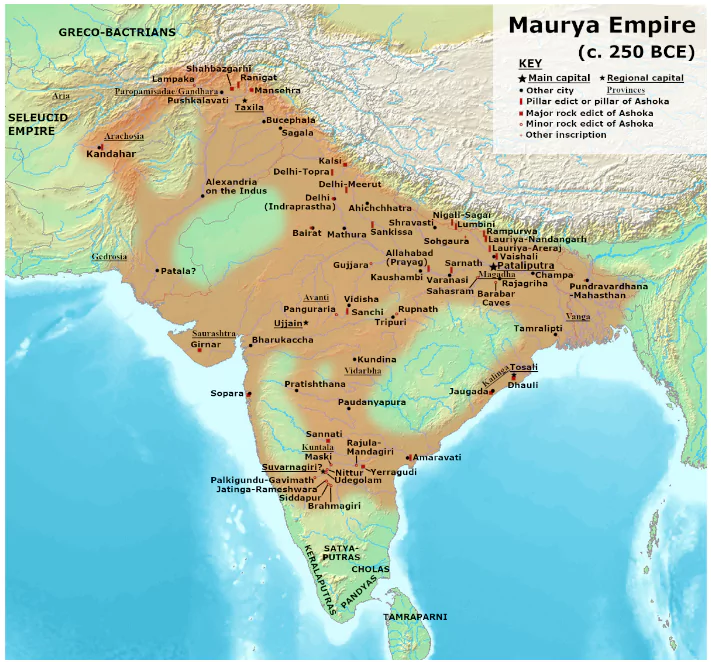Chandragupta Maurya, the founder of the Maurya Empire, was a pivotal figure in ancient Indian history. Rising to power in the 4th century BC, he established one of the largest empires in ancient India, encompassing much of the Indian subcontinent. He overthrew the Nanda dynasty and established Maurya rule in 321 BC with the help of Chanakya (Kautilya). Greek historians mention him as ‘Sandrakottus’, a modified form of Chandragupta.
Major Achievements of Chandragupta Maurya
- War and Conquest: Chandragupta Maurya raised an army that eventually conquered the Nanda capital Pataliputra and defeated him.
- This defeat marked the fall of the Nanda Empire.
- Defeated Seleucus (Alexander’s general, who established his kingdom extending up to Punjab after the death of Alexander) in a battle around 301 BC, driving him out of the Punjab region.
- Peace Agreement: Seleucus gave him eastern Afghanistan, Baluchistan, and the area west of the Indus.
Megasthenes
He was a Greek ambassador, sent by Seleucus Nikator to the court of Chandragupta Maurya. He lived in the Mauryan capital of Pataliputra.
- He wrote Indica, which describes the subcontinent’s physical, administrative, and cultural features.
- Megasthenes mentioned that famine has never visited India, and there has never been a general scarcity in the supply of nourishing food, even during the war.
- He states that there were seven castes in Mauryan society: artisans, farmers, warriors, philosophers, herders, magistrates, and council members.
|
- Territorial Expansion: He ruled the whole subcontinent, including Bihar, portions of Orissa and Bengal, western and northwestern India, and the Deccan except Kerala, Tamil Nadu, and parts of northeastern India.
- Justin, a Greek writer, claimed Chandragupta conquered India with a vast army.
- Administration: Indica and the Arthasastra (compiled a few centuries after the Maurya rule) provide insights into the administration.
- The Central government had about two dozen departments controlling social and economic activities, particularly near the capital.
- The empire was divided into several provinces led by royal family members. Provinces were further divided into smaller units.
Enroll now for UPSC Online Course

Chanakya
- He is also known as Kautilya and Vishnugupta.
- Contemporary Jain and Buddhist texts did not mention him, but popular oral tradition ascribes his wisdom and genius.
- He was the author of the Arthasastra, a treatise on political strategy and governance.
- The play Mudrarakshasa by Visakhadatta (written during the Gupta period) narrates Chandragupta’s accession to the throne of the Magadha Empire and the exploits of his chief advisor, Chanakya.
|
- Army: Their military might was greater than Nandas.
- Pliny (a Roman writer) mentions a massive army containing foot soldiers, cavalries, elephants, chariots, and the navy.
- The armed forces were managed by a board of 30 officers divided into six committees, each overseeing different military branches – army, the cavalry, the elephants, the chariots, the navy, and transport.
- Taxation: Agriculture on newly cultivated land was state-controlled.
- It was done with the help of cultivators and sudra labourers, and taxes were collected on it.
- Taxes on peasants ranged from one-fourth to one-sixth of their produce, with the state charging for irrigation and levying tolls on commodities at town gates.
- The state monopolized mining, liquor sales, and arms manufacturing.
The Junagadh Inscription
- It was carved during the reign of Rudradaman near Girnar in Gujarat and dates back to 130–150 CE.
- It refers to Pushyagupta, the provincial governor (Rashtriya) of Emperor Chandragupta.
- It provides insights into The extent of the Mauryan Empire, which had expanded as far west as Gujarat.
- It records the construction of Sudarshana Lake in the 4th century BC during the reign of Chandragupta Maurya. It was completed during the reign of Ashoka. The Shaka ruler Rudradaman I repaired the lake around 150 AD.
|
Conclusion
- According to the Jain traditions he probably renounced the world and spent his last years as an ascetic in Chandragiri, near Sravanabelagola, in Karnataka. Chandragupta Maurya’s legacy as the founder of the Maurya Empire is profound. His military conquests and administrative reforms laid the foundation for one of the most powerful empires in ancient India.
- Through his strategic alliances and governance, he united much of the Indian subcontinent, ushering in an era of stability and prosperity. Chandragupta’s reign marks a pivotal moment in Indian history, highlighting his remarkable leadership and enduring impact on the subcontinent.
![]() April 25, 2024
April 25, 2024
![]() 5045
5045
![]() 0
0
